
AE 1250 - Walking With Pete
I Had To Go To The Hospital
Learn Australian English in this
Advanced English Listening Skills Practice Lesson!
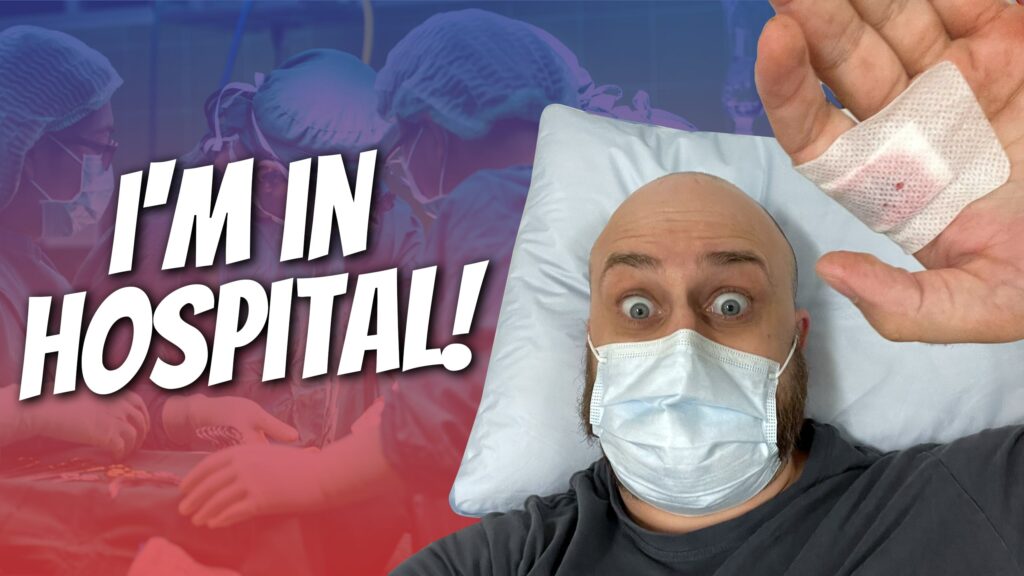
In today's episode...
G’day mates! In this ripper episode of Aussie English, our mate Pete ditches the usual walking format to share a fair dinkum yarn about a recent trip to the hospital. So, he’s chilling at home, innocently trying to propagate a monstera plant when things take an unexpected turn.
Pete spills the beans on the whole saga – from the plant-cutting mishap to his visit to the local hospital’s emergency department. He walks you through the Aussie way of handling medical stuff, like the triage process, the cost if you don’t have Medicare, and what it’s like waiting in the ER.
Now, brace yourself for the stitchin’ part. Pete dives deep into the experience of getting stitches, describing the odd sensations and throwing in a bit of humor. He even spills the beans on the bonus he scored – the tools to remove the stitches at home! Who knew hospital visits could come with a DIY element?
Despite the seriousness of the situation, Pete keeps it fair dinkum with his classic Aussie humor, sharing language insights and giving you a bloody good yarn. So, if you’re keen to learn about Aussie medical lingo, laugh a bit, and get a sneak peek into the Aussie healthcare system, chuck this episode on your playlist. Pete’s got the lowdown on stitches, plant propagating, and a bit of Aussie charm. Tune in, legends!
** Want to wear the kookaburra shirt? Get yours here at https://aussieenglish.com.au/shirt **
Improve your listening skills today – listen, play, & pause this episode – and start speaking like a native English speaker!
Listen to today's episode!
This is the FREE podcast player. You can fast-forward and rewind easily as well as slow down or speed up the audio to suit your level.
If you’d like to use the Premium Podcast Player as well as get the downloadable transcripts, audio files, and videos for episodes, you can get instant access by joining the Premium Podcast membership here.
Listen to today's episode!
Use the Premium Podcast Player below to listen and read at the same time.
You can fast-forward and rewind easily as well as slow down or speed up the audio to suit your level.
Transcript of AE 1250 - Walking With Pete: I Had To Go To The Hospital
Alrighty. G'day, guys. How's it going? Welcome to this episode of Aussie English. The number one place for anyone and everyone are wanting to learn Australian English. Now, I hope you guys are having a good day. I thought we would mix things up a little bit, change things up. I haven't done a walking with Pete episode in quite a while. And although I'm not walking at the moment, I thought I would just do a kind of spontaneous episode where I have a chat with you guys. Talk about my recent trip to the hospital. And the main reason for this was not because I'm trying to elicit sympathy from you. I'm not trying to get, um. Yeah. I'm not trying to get your sympathy. I'm not trying to have a whinge, have a cry.
But I thought it might be a good excuse to talk about a topic that we don't often talk about on the podcast. You know, medical stuff, going to the hospital, anatomy, what we're going to cover. You know, we'll get into the nitty gritty shortly. We'll get into the detail shortly. But I thought it would be a good excuse to talk about that. And yeah, give you some, some understanding of what the process is like going to the hospital here in Australia. And also, yeah, use some of this vocab.
So it happened, I put myself in hospital the other day because I think it would be- today's Monday. So it would have been a Saturday and I screwed up things with my wife. My wife was planning to go out Saturday evening, I think about 4:00. She wanted to go into the town, into Geelong to have dinner with her friend and then go to a movie. And I screwed that up because we'd gone out to swimming lessons with the kids in the morning.
So they have swimming lessons every weekend. We take them to a local pool and they put on their bathers, and they've got goggles and all that sort of stuff. They get in the water, frolic around, have a bit of a play for, you know, 10 to 20 minutes and then they have their swimming lessons where they learn things like, you know, just the basics. I guess at the moment they're still pretty young, so they're not learning anything too advanced, but just getting comfortable with the water and how to get out of the pool if they fall in that sort of stuff.
Australia's very safety minded around this stuff because drownings are so common, because everyone lives near, near the beach or near a river or billabong or lake or whatever it is. So. So yeah, anyway, we went to swimming lessons and then when we came home, I wanted to cut up one of my plants to propagate it. Right. So to propagate, if you propagate a plant. In terms of indoor plants, which are relatively easy to propagate, that is usually chopping them up and then putting them in water and leaving them in the water for, I don't know, a few weeks, maybe a month or two.
And they grow roots out of the cuttings that you've taken, right? They're called cuttings when you get, say, an indoor monstera. This is a genus of indoor plant, right. The Swiss cheese plant. Fruit salad plant. I've forgotten what the Brazilian name for it is. It's like, is it like Adam- Adam's rib plant or something like that? There's some interesting name that they give it. But, yeah, that's a common one, right? You'll know it if you see it. It's everywhere.
But they grow like a vine, right? They're meant to grow up trees. And so they have nodes, which is where the leaves come out of every few centimetres or so. And if you chop the vine up into single node cuttings, you can put these cuttings in water and the nodes will grow roots. And you can then plant them in soil. And you've got, you know, many plants from what was originally a single plant. So I was doing that with a monster, a large one that I've got because I wanted to sell some of these cuttings.
And usually what I do is I use, I use a very sharp razor blade. So I buy razor blades from Bunnings. You can get these things that you can, you well, yeah, you can use them just as is that- they're the standard kind of like rectangular shaped, sharp, really sharp razor blades. And you can- they've got like iron, sort of like, binding or something on one side so that you can hold it relatively easily. Anyway, I'm used to using these all the time.
And the reason that you want to use something like a razor blade when propagating plants is because you need something really sharp to cut through the stem of the plant, to make sure that the cut is as smooth as possible. Because if you use something like scissors or secateurs or shears, as they're called elsewhere, quite often one or both sides of those will actually crush part of the plant's flesh, and this can cause rotting when you're propagating them in water. So you want the cut to be as clean as possible, so that when the the surface of the cutting dries, it doesn't rot in the water. Whereas if you crush it using scissors or something, it can rot.
So anyway, that's why I was using a razor blade. What I wasn't using was gloves because I had too much confidence. So I was chopping through this monstera's stem, and I had gotten through a few nodes, and there was one that was being, particularly troublesome. It was a bit tough, I think as you work your way down from the newer part of the plant, down to the older part at the bottom of the plant, it tends to get woodier and harder to chop through.
So I was using my left hand to kind of hold the plant, the node in position whilst trying to wedge, sort of like seesaw, move back and forth the razor blade through the stem of the plant and you know, it kind of crunches through. It's the consistency is kind of like a kind of a fibrous carrot, you know, so when you go through that kind of crunches, but it's a sort of carrot kind of consistency.
Anyway, all of a sudden the the stem snapped. It kind of gave way when I was about three quarters of the way through, and I wasn't expecting it. And I ended up pushing the razor blade all the way through and into my hand. And initially I was like, Oh, I've just bumped it into my hand. But I stopped it in time and I haven't cut myself. But then when I looked down, I could see fat and muscle in my hand and a big gaping wound.
So I walked over to the sink and went incredibly quiet. My wife and kids were in the lounge room as well, and they were just doing their thing. And she my wife looked over. Kel looked over at me and was just like, What's going on? And I was washing my hand under the sink and then had another look at it and could see I had about an inch, an inch and a half cut, so maybe four centimetres, maybe three centimetres in my hand.
And I could see the tissue of my muscle and tendons and some of the fat in my hand through the cut. So I knew immediately I needed stitches because although obviously you could just leave it. You're likely to get an infection if it's not sealed and all. You know, I was using a razor blade that I was using to cut up plants that are sitting in soil, so it's probably not, you know. Great. It's not not ideal.
And also, if you don't get the cut closed over, you'll end up with a massive scar, right? So, you know, you think about warriors back in the day, people who were fighting in wars with swords and everything like that, they got cuts and they lived and survived getting these huge gashes and cuts and everything. But as a result, they ended up with massive scars because the wound tends to stay open and then heal slowly. So I wasn't really keen for that. So I kind of took a deep breath and yeah, tried to stop freaking out. I put some, I cleaned, I disinfected my hand straight away, so I had like, iso- I have isopropyl alcohol in the in the cupboard that I use, usually to disinfect the razor blades between cutting up plants.
So I just poured that on my hand. That stung like a bitch. That really, really stung. But, you know, I needed to disinfect it. Put a BandAid on it, and then I wrapped a bandage around it, and I happen to have some sort of small bandages nearby which I'd bought for another reason, but we'll go there another time.
So I did that, and then initially I was like, Oh, Kelly, are you able to drive me into the hospital? Like, I'm sorry about this, but can you take me in? Because I don't know if I'll be able to drive or not? And then I sort of had a think and I'm like, you know what? Screw that. We'll end up at the hospital for ages. The kids are just going to be running around like psychos, you know, upset, bored, just going stir crazy. So maybe it's better you stay here and I'll just drive myself in because it's my left hand. The car's a manual, not a manual. It's an automatic car, so I don't have to use my hand to do anything. I'll just. Yeah, I'll just drive in and I'll deal with it.
So I think that was it about maybe 1:30, 2:00. So anyway, I ended up at the hospital, I drove in and I was okay. I think the main thing Kel was worried about was me fainting or something. Because I'm one of those people who's a little- I get nauseous with this sort of stuff. It's really weird. I can kind of watch it happening to other people, like if someone else was bleeding or if they were getting you know, stitches. I've seen operations, all that sort of stuff. You know, I can handle watching other people do it.
But when it's me, myself, for some reason, I think my blood pressure just drops and I feel like I'm going to faint. And sometimes I have fainted. Well, I fainted once when having my blood taken and not lying down, so yeah. Anyway, I was feeling, you know, sort of okay. So I was driving, drove into the hospital, parked, and I went into emergency. So obviously, you know, this is going to be the same everywhere around the world if you hurt yourself, typically you go to the hospital. And if it's something really serious that needs to be kind of dealt with then and there, you know, that day, right? It's not a, you know, a splinter or a bruise or something that, while it may need attention, isn't going to, you know, isn't pressing.
Something that's serious, you walk in. And so when I walked into the hospital, they have these two kind of like coloured arrows on the ground as you walk into emergency. The red one is the one that you meant to take first, and it takes you up to the nurses where they look at your, your wound. Whatever issue you've got, they hear, you know, you tell them what the problem is and then they triage you. So they give you a kind of a ranking of how serious your issue is and how quickly it needs to be addressed. Right.
Because obviously, if you've been shot and you're bleeding out, you're going to be triaged at the most serious level so that you can see a doctor immediately. Whereas if you've got like a, um, I don't know, like, well, a cut like me, it's probably the least serious, the least life threatening. And so you can, you know, be triaged as yeah, of least concern. So anyway, the good thing was, when I walked in, I noticed instantly that there were barely any people there. So I was like, Thank God I'm not going to be here for the entire night sitting around waiting for this to happen.
Because I remember during Covid, our kids a few times had, I think it was Noah. Noah had really bad fevers one day, and he was getting them like every two hours. And it was putting him into, I don't know, he was almost like he was almost comatose. Right? Like he was getting a fever and just exhausted and barely able to move.
And then and, you know, half an hour, an hour later, he'd be back and fine, and then it would happen again. And we were just like, what the hell? So we went into the hospital, and I remember we had to wait, I think four hours before we actually got to see anyone. It was just brutal. And by the time we saw someone, Noah was all better. You know, he was pretty much just his, his normal self. So it was kind of like, all right, just watch. Watch for what happens.
Anyway. So, went in, barely anyone there. So I was kind of like, Okay, cool. Hopefully I get to see someone pretty quick. And then after getting triaged, they send you around the corner following a blue arrow blue line to the person that takes your details. And I think for you guys, this would be where you if you are, if you're not Australian, or you're, you don't have a citizenship, or you don't have Medicare. Really, it comes down to Medicare, right? It's, which is automatic.
If you have a permanent resident visa or you are a citizen, if you don't have Medicare, you have to go around that corner and you'll probably have to give them your health care, your health insurance information and or contact information. And I think if you don't, even if you don't have insurance, you may have to pay a fee.
I remember when I went in, we were in Wodonga and I had something stuck in my foot because I stepped on a, I stepped on something in the ocean, and I thought I had a sea urchin spine or something stuck in my foot. I went to the hospital there, and I remember seeing a sign saying if you didn't have Medicare, you had to pay. I think it was $850 up front. So it can be quite significant. If you don't have health insurance, and you don't have Medicare, be aware that if you go to emergency just to be seen by a doctor, it can be quite a significant fee.
So yeah, I went, gave them my information. Then they sent me to the room where I had to wait, and I was. In the fast track room, so they put me in there. I'm sitting down, but it was just full of people. It was a very small room, and there was like a person in every single chair, and I was kind of feeling a bit nauseous at that point because I'm like, yeah, I was just sort of like, Oh my gosh, I hope I haven't done nerve damage. I hope I didn't hit the bone. I hope it's not going to be serious. What if I need surgery? I was getting in my own head, so I ended up freaking out a little bit.
Not, not that bad, but I was like, You know what? I'm going to try and go outside and just get some fresh air and walk around. The other thing was, I have to wear a mask right? When you go into the hospital still you have to wear masks. And it was just a bit hot in there and especially with a mask on your face, you just feel a bit claustrophobic. So what I did was because I wanted to wait outside, I went and spoke to the people that were via that blue arrow around the corner where they were the ones taking your details. And I just said, Can I ask you guys to give me a phone call when the doctor's ready? And they were like, Yeah, sure, no problem.
So that's an option for you to just be aware that if you go to the hospital and there's loads of people around and you don't want to necessarily wait inside, another reason may be that you don't want to get ill, right? If there's people with Covid or other infectious diseases in there, perhaps you don't want to just be sitting around near them breathing in what they've, you know, exhaling.
So I asked if I could just go wait outside in my car and chill out there and they could just call me? And the guy was like, Yeah, it'll be a no number. It'll come up when they're ready and just walk in. So I went and waited in my car and was just reading a magazine for about 20 minutes, maybe half an hour. And then I got a phone call and had to come in.
So I went into the next through the door into the next sort of area. And this was a waiting area, but with nurses and doctors, and they were attending 3 or 4 patients that could sit down there in that section. The nurse was a young Chinese, woman of Chinese heritage. She had come from China. So I was like, Ni hao ma. I was showing her a bit of my Chinese and she was, I think she must have been pretty new.
And she was looking at my hand and she the wound had kind of closed up at that time, and it looked a lot less serious than it actually was, because the edges had kind of come together and the blood had dried and it looked like, ah, just a little cut. And she was like, Ah, you may be okay, but I'll go get the doctor who's in charge of this stuff to come and have a look. And then we'll let you know. He came through probably about 20 minutes later and had a poke around. So he was like, Do you mind if I have a look? Do you mind if I have a poke around? Meaning, you know, Can I prod and poke your your hand?
And immediately he just opened it up. Right. He just used his fingers to separate the skin and he was like, Look, you can see fat, muscle, tendons. He definitely needs stitches. So, that guy then buggered off and they had me come around a corner and wait in another area near the rooms. And the thing that kind of freaked me out a little bit was they were like, Look, it's pretty busy and there's loads of people here at the moment in the rooms. Can we just do this in the seat here?
Like, if we just bring the equipment out, can we just sew your hand up here? And I was I would have been okay with it if it was going to be fast, but it was going to take quite a while because it was this young girl Hue - It was her first time sewing up a wound. And I was like, You know, you should learn. Do it on me, you know, go for it. So they ended up going and finding a room, and another 20 minutes later, I went in and lay down and they. Yeah, had at it.
So I think the first thing was giving me an anaesthetic. They had to push. Well, Hue had to push a needle in from the back of my hand to the front of my hand. And pull the needle backwards as she injected anaesthetic, I think, from memory, and it kind of stung a little bit and then went a bit hot, and then I couldn't feel anything. And that entire part of my finger from the sort of palm all the way up my finger just went numb, and I could. I could feel pressure and everything, but I couldn't feel pain. Yeah.
Just like going to the dentist when you get the anaesthetic in your mouth and you have a feeling or something, it's that same sort of feeling, obviously. So that was interesting. I didn't realise they were going to have to come in from the back of the hand, and the reason for that was that apparently the front of the hand is obviously where all the nerve endings end, where they all come to. So it's a lot more sensitive.
And so they were like, Yeah, it's actually less painful to go through the back of the hand than the front of it. So yeah, they did that, waited five minutes for the anaesthetic to start working and for the numbness to kind of creep all the way up my finger and everything. And then she got the needle and thread out and started doing the stitches. So I think, I think I only actually got one stitch. They were thinking about two, but it looks like it's only one. And there's glue on either side of the stitch.
The thing that kind of freaked me out whilst this was going on was that the entire time the main doctor was telling her all about everything, right? Like kind of explaining everything that was going on the different parts of my hand that he could see, what she was meant to be aiming for. What to avoid.
You know, when you put the needle in here and you're doing the anaesthetic, make sure you don't hit the bone. If you hit the bone, you're going to hear this kind of a sound or feel this kind of a thing. And I was just like, Oh my God, I really don't want to be thinking about this. But at the same time, it was good that she got to do this and got to learn, you know, something that is an important skill for doctors. She put the stitch through, so they used this curved needle, and it comes in at kind of like a 90 degree angle under one side of the cut, and then goes through the next side of the cut and loops, you know, out. And then they tie a knot, pull it tight and it closes the wound over with that stitch. Right.
The annoying thing was that as she was doing it, she, she'd almost finished and she accidentally pulled the thread the entire way through the wound, right, before she tied it off.
So she had to start again. But I think she just used the same holes, and it was pretty quick to finish up. The only weird thing here, like, at this point, I could feel the pressure and the movement, but it didn't really hurt. It stung a little bit. I think the anaesthetic probably hadn't completely worked in all the different area that was getting treated, because I could. It did sting a little bit towards the end there, but to be honest, it was, you know, the kind of pain of popping a pimple or pinching yourself. Really. It was not bad at all.
So yeah, it was just interesting having kind of feeling my skin moving around and getting pulled and prodded and then tied together. And then after that they put some tape on it and it was all good to go. The cool thing was I was kind of like, do I need to come in and have this stitch out? Is it going to dissolve? What's the deal? And the guy was like, Look, you've got a single stitch, you can come in next Friday. That's when I would recommend getting it out, you know, six days. And he was like, but it's a single stitch.
And I said, Can I just take this out at home? Like, to be honest, I feel like it's it's something I can do at home. Instead of having to drive half an hour to the hospital, hang around for however many hours or hour or whatever, wait for a doctor to be available for him to then just come. And literally, you know, I imagine it would be a ten second process. This feels like a massive waste of resources and time. Can I just do this at home?
And he was like, Yeah, I'll give you the equipment. So he ended up giving me the forceps, scissors and a razor blade, a curved one that goes, you can use to sort of flick up and under the line and it cuts it. So it's kind of like a hook with the inside of the hook sharp and the outside blunt, so it can hook the thing and cut it.
So I'm just going to watch a YouTube video, to be honest. And then do it on Friday, probably Friday afternoon or something. But the good thing is that the interesting thing was that it didn't hurt when I cut myself. Right. So I must have done it so fast, and it was so sharp being a razor blade that there was like zero pain. Initially I just thought I'd whacked myself. And then it didn't bleed very much. I kind of just put pressure on it, put a Band-Aid over it, and kept my fist closed, and it didn't bleed a lot. So I hadn't hit, you know, arteries or veins. Fortunately, they asked me those sorts of questions.
One thing to note, they were like, you should have taken a photo as you'd done it. And I was like, I wasn't really thinking about that. But they were like, if you take it a photo, we would have seen instantly what the issue was and we wouldn't have to prod around or anything. So next time you guys end up hurting yourselves and going to the hospital, try if it's something like that, a cut or something, and they're concerned about how deep it is, take a photo of it and they may not have to prod around before getting to it. But yeah, I forgot my train of thought.
That was really it. They put the tape over the top of it. Some medical tape. Yeah. It was, it's been fine to be honest, I wouldn't- Like, it's two days later now recording this. There's no inflammation. Well there may be a little bit of inflammation. There's no infection. So it's not red. It's not painful. The only little bit of pain I get is if I put pressure on it, you know, which I imagine is just. Yeah, probably slight inflammation below the wound where it's all healing up. But it seems to be really good. It seems to be healing fast. There's glue on either side of the stitch which is holding the wound together. I think it's super glue.
And the only thing that's kind of bummed me out, that's made me a bit sad, is that I can't play guitar because it is right in the spot on my left hand. My first, my index finger. It is at the base of my index finger where it touches the palm, right? Right above that knuckle, which is where you would rest the guitar's neck when you're holding the guitar. If you're playing it left, well, right handed, but with your left hand.
So I'm a bit bummed out at the moment because I can't play guitar because it sort of just hurts, and I don't want to aggravate that area at all. But that's been my experience. The interesting thing was even- Yeah, I was a bit confused at the end after I'd had the stitch and everything, and he was like, Yeah, no worries. So we're all good. I was like, Do I just leave? Like, do I need to talk to someone? Like, is there, do I, do I pay something? Do I, you know, is there a follow up thing?
And he's just like, Oh, you can just walk out. So. So, yeah, that was interesting. I didn't realise it feels, it feels a bit weird once you've sort of been at least in that, you know, scenario. I've been treated and he was just like, you can just go. I was like, Okay, sorry.
Anyway, so that's been my little visit to the hospital. And to be honest, although it's quite small, this is the most serious thing that I think I've ever had to go to the hospital for besides being born myself. Fortunately, you know, again, hopefully I haven't jinxed it, knock on wood. But that is, yeah, the worst thing that I've done to myself where I've needed medical attention at the hospital.
So anyway, hopefully you guys enjoyed this episode. Hopefully it wasn't too gruesome. I just thought it would be an interesting exercise to be able to talk about medical things, you know, injury, wounds, stitches, all that sort of stuff, whilst also helping you understand what it's like. That process of going to the doctor, going to the the hospital and Medicare or insurance or all that sort of stuff. Right. So I know that, you know, knock on wood, some of you guys, there are thousands of you guys listening. I'm sure some of you guys, at some point or another, are going to end up in hospital in Australia for one reason or another. Hopefully it's something trivial, like cutting your hand with a razor blade, but hopefully this this gives you a little bit of vocab and knowledge about what the process is kind of like.
Anyway, that's it for me today. I hope you've enjoyed the episode and I'll chat to you next time. See you later!
Get more out of every episode!

Premium Podcast members get access to...
- All 900+ podcast episodes including member-only episodes
- Member-only episode video lessons
- Downloadable transcript PDFs & audio files for every episode

Recent Episodes:


AE 1299 – Pete’s 2c: Do You Ring, Call, or Dial Someone on the Phone in Australia?

AE 1298 – Learn English with a Short Story: Day at the Beach

AE 1297 – The Goss: How ‘Dropping In’ Culture Has Changed in Australia

AE 1296 – The Goss: Gorilla Glasses & Dad’s Crazy Zoo Stories – MEMBERS ONLY

AE 1295 – The Goss: Australia’s Most & Least Ethical Jobs

AE 1294 – The Goss: Australia Just Had the Best Aurora in 500 Years!

AE 1293 – The Goss: Should Aussie Schools Ban Homework?

AE 1292 – How Aussie Do Asian Australians Feel? r_AskAnAustralian
Share
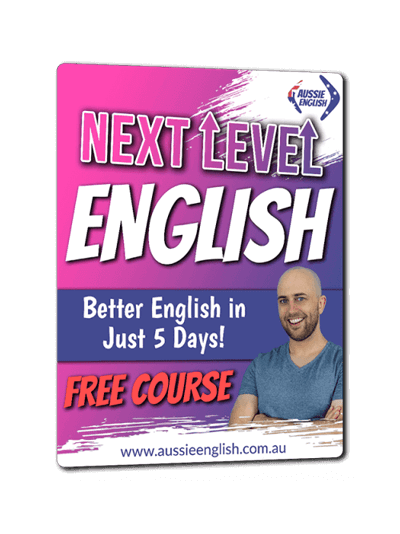
Join my 5-Day FREE English Course!
Complete this 5-day course and learn how to study effectively with podcasts in order to level up your English quickly whilst having fun!

Join my 5-Day FREE English Course!
Complete this 5-day course and learn how to study effectively with podcasts in order to level up your English quickly whilst having fun!


Want to improve a specific area of your English quickly and enjoyably?
Check out my series of Aussie English Courses.
English pronunciation, use of phrasal verbs, spoken English, and listening skills!
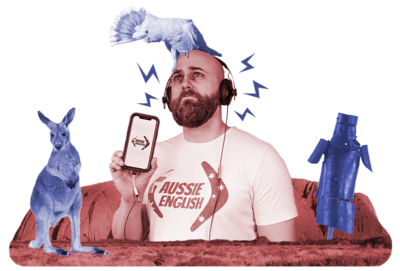
Have you got the Aussie English app?
Listen to all your favourite episodes of the Aussie English Podcast on the official AE app.
Download it for FREE below!


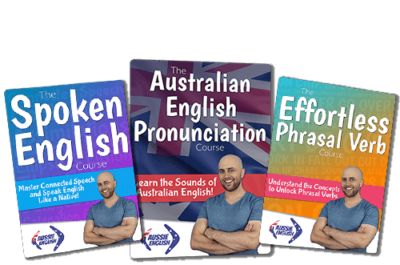
Want to improve a specific area of your English quickly and enjoyably?
Check out my series of Aussie English Courses.
English pronunciation, use of phrasal verbs, spoken English, and listening skills!
Leave a comment below & practice your English!






Responses
get well soon
Thanks, mate!
Please generate more content like this. It’s really helpful for daily life and it’s much more better than the news on podcasts. I can’t connect with your podcast but these parts really helped me. Thank you